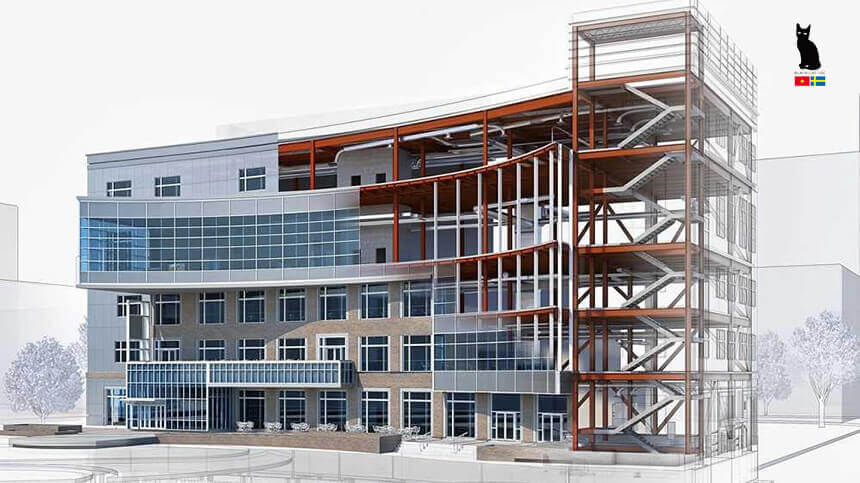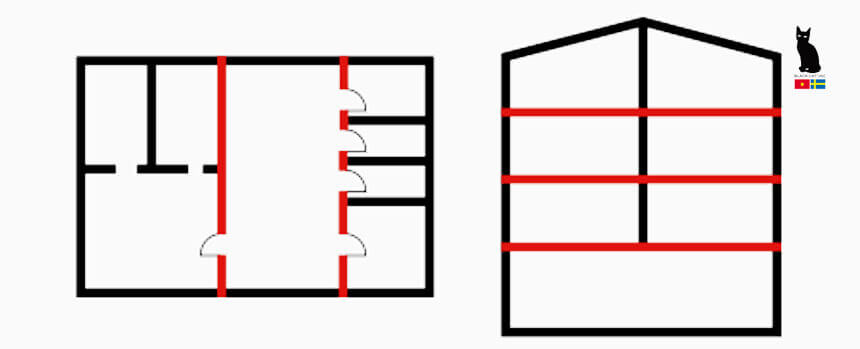
Passive Fire Protection – An Important Element of Fire Safety Strategy
By admin . October 29, 2020 | News
Fire proofing is an important factor for constructing a safe building. It includes the total amount of measures, which are planned and implemented in a building, and also those which are taught to occupants of the building.
It’s something you lose sleep over and hope will never happen: a fire roaring through your building. While every facility professional will do what he or she can to ensure that a fire never begins in the first place, the next step is knowing how to minimize its spread.
Most people are familiar with the basics of fire suppression (sprinklers, fire extinguishers, etc.), but the passive fire protection that actually contains a fire at its point of origin can be invisible and nearly forgotten – until the day you come to truly appreciate and depend on it.
What is Passive Fire Protection?
Passive fire protection (PFP) is a vital component of any fire safety strategy. It is built into the structure of a building to safeguard people’s lives and limit the financial impact of damage to buildings and their contents. It does this by:
- Limiting the spread of fire and smoke by containing it in a single compartment
- Protecting escape routes for essential means of escape
- Protecting the building structure thereby ensuring it’s sustainability
Passive Fire Protection is built into the structure to provide stability and into walls and floors to separate the building into areas of manageable risk – compartments. These areas are designed to restrict the growth and spread of fire allowing occupants to escape and offering protection for firefighters. Such protection is either provided by the materials from which the building is constructed, or is added to the building to enhance its fire resistance.

Compartmentation
Compartmentation is a defined area in a building, which limits the spread of fire and smoke. The size and number of compartments are defined in all national building codes – dependent on the floor area or volume and the amount of fuel in each level. Building codes differ from one country to another. Compartments are always vertical (fire rated floors/ceilings) and horizontal (fire rated walls). As all kind of services are required in those boxes, openings are created, which have to be protected again. An obvious and always visible protection is a fire door. But also where all kind of services such as cables, pipes, ducts, etc. are running through, the tightness of the compartment has to be ensured again by installing adequate penetration seals.
Those penetration seals are mostly a combination of several products such as coatings, mortars, collars, wraps, sealants, backing material and here the key questions is how materials interact. At Black Cat, we test full wall and ceiling systems with all of the potential service penetrations in situ.
Fire Tests & REI
As all systems are fire tested the result is a certain fire resistance, which is shown in a fire rating value. All test standards, EN/ASTM/BS/, define clearly how the fire rating has to be indicated in reports.
For loadbearing elements additionally the applied load and/or load level shall be included. For penetration seals and joints additional elements are required such as pipe end configuration.
Most important are the definition of Stability, Integrity, Insulation and Loadbearing capacity.
Stability and Integrity (E)
These are the times in completed minutes for which the test specimen continues to maintain its separating function during the test without Ignition of cotton pad, or passage of gap gauge, or sustained flaming.

Insulation (I)
This is the time in completed minutes for which the test specimen continues to maintain its separating function during the test without developing temperatures on its unexposed surface which, increase the average temperature above the initial average temperature by more than 140°C (not valid for penetration seals); or increase at any location above the initial average temperature by more than 180°C (valid for penetration seals).
Loadbearing Capacity (R)
This is the ability of the element of construction to withstand fire exposure under specified mechanical actions, on one or more faces, for a period of time, without any loss of structural stability.
Fire Ratings
So a fire rating of EI120 means that the system will keep the tightness of the compartmentation in case of fire for the passage of flames (E) for 120 minutes and for the passage of heat and flames (I) also for 120 minutes. A fire rating of E120 and EI90 would mean an integrity (E) – passage of flames – of 120 minutes and insulation (I) – passage of heat and flames – of 90 minutes.
What Is The Difference Between Fire Resistance And Reaction To Fire?
Fire resistance is preventing the spread of fire from one compartment to another and is tested for every system.
Reaction to fire measures the material behaviour per product and how it contributes to the growth of a fire. This is important in a hotel building, where furniture, curtains, carpets, etc. should be non-combustible or low combustible.

Many construction materials have some natural resistance to fire and as such already have built-in fire protection. An example of such a material would be clay bricks, which, when constructed to form a wall is fire-resisting in its own right. Other materials e.g. timber used in the construction of a timber floor may have little such built-in fire protection and may require additional protection e.g. in the form of fire resisting boards fixed to the underside of the ceiling below.
Fire resistance may be enhanced by the use of added materials or components that are known by the collective term passive fire protection (PFP).
PFP Products Include:
- Fire protection to the structural frame of the building
- Fire-resisting doors and fire door furniture
- Fire shutters
- Compartment walls and floors
- Fire-resisting walls and partitions
- Suspended ceilings
- Fire-resisting glazing
- Fire doors and hardware
- Industrial fire shutters and curtains
- Fire fighting shafts and stairwells
- Fire-resisting dampers (mechanical or intumescent) used in horizontal or vertical air distribution ducts
- Fire-resisting ductwork
- Fire-resisting service ducts and shafts
- Penetration seals for pipes, cables and other services
- Cavity barriers
- Fire-resisting air transfer grilles (mechanical or intumescent)
- The building envelope, e.g. fire-resisting external walls, curtain walls etc.
- Reaction to fire coatings
- Hydrocarbon structural fire protection systems

